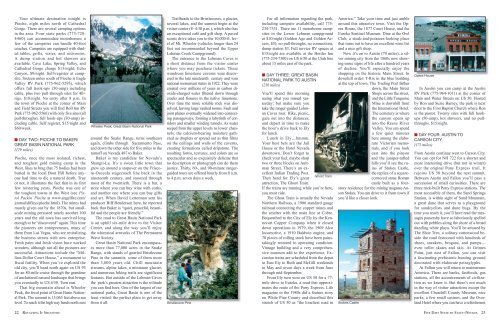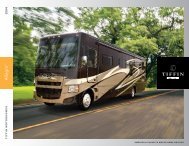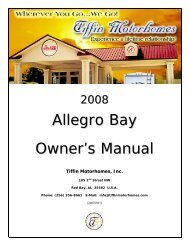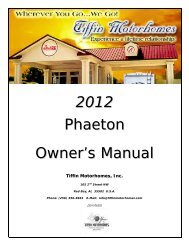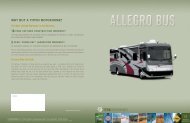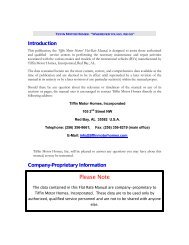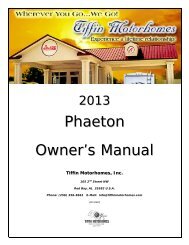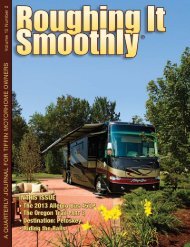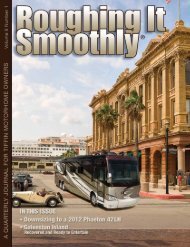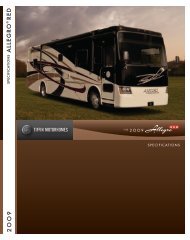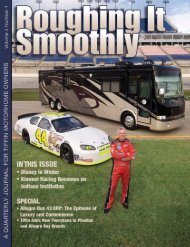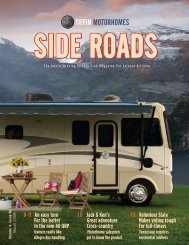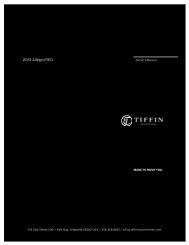Roughing It Smoothly - Tiffin Motorhomes
Roughing It Smoothly - Tiffin Motorhomes
Roughing It Smoothly - Tiffin Motorhomes
You also want an ePaper? Increase the reach of your titles
YUMPU automatically turns print PDFs into web optimized ePapers that Google loves.
Your ultimate destination tonight is<br />
Pioche, eight miles north of Cathedral<br />
Gorge. There are several camping options<br />
in the area. Four state parks (775-728-<br />
4460) can accommodate motorhomes; a<br />
few of the campsites can handle 40-foot<br />
coaches. Campsites are equipped with shaded<br />
tables, grills, water, and restrooms.<br />
A dump station and hot showers are<br />
available. Cave Lake, Spring Valley, and<br />
Cathedral Gorge charge $13/night; Echo<br />
Canyon, $9/night. Self-register at campsite.<br />
Sixteen miles south of Pioche is Eagle<br />
Valley RV Park (775-962-5293), which<br />
offers full hook-ups (50-amp) including<br />
cable, plus two pull-through sites for 40+<br />
rigs. $18/night. No entry after 8 p.m. In<br />
the town of Pioche at the corner of Main<br />
and Field Streets you will find Roll Inn RV<br />
Park (775-962-5566) with only five sites (all<br />
pull-throughs), full hook-ups (30-amp) including<br />
cable. Self register, $15/night and<br />
$60/week.<br />
■ DAY TWO: PIOCHE TO BAKER/<br />
GREAT BASIN NATIONAL PARK<br />
(129 miles)<br />
Pioche, once the most isolated, richest,<br />
and roughest gold mining camp in the<br />
West, likes to brag that 75 bodies had been<br />
buried in the local Boot Hill before anyone<br />
had time to die a natural death. True<br />
or not, it illustrates the fact that in its first<br />
few roistering years, Pioche was one of<br />
the toughest towns in the West (see Pistol<br />
Packin’ Pioche at www.angelfire.com/<br />
journal/difleys/pioche.html). The mines had<br />
mostly given out by the 1870s, but smallscale<br />
mining persisted nearly another 100<br />
years and the old town has survived long<br />
enough to be “discovered” again. This time<br />
the pioneers are entrepreneurs, many of<br />
them from Las Vegas, who are revitalizing<br />
the business streets with new enterprise.<br />
Fresh paint and fresh vision have worked<br />
wonders, although not all the pioneers are<br />
successful. Attractions include the “Million-Dollar<br />
Court House,” a monument to<br />
fiscal futility. When you’ve explored the<br />
old city, you’ll head north again on US 93<br />
for an 80-mile cruise through the grandeur<br />
of uncluttered natural landscape that brings<br />
you eventually to US 6/50. Turn east.<br />
That big mountain ahead is Wheeler<br />
Peak, the focal point of Great Basin National<br />
Park. The summit is 13,063 feet above sea<br />
level. To reach it the high way bends north east<br />
Wheeler Peak, Great Basin National Park<br />
around the Snake Range, turns southeast<br />
again, climbs through Sacramento Pass,<br />
and down the other side for five miles to the<br />
turnoff on Nevada 487 to Baker.<br />
Baker is my candidate for Nevada’s<br />
Shangri-La. <strong>It</strong>’s a sweet little town that<br />
grew up around a stopover on the Friscoto-Osceola<br />
stagecoach line back in the<br />
nineteenth century, and snoozed through<br />
most of the twentieth. There is a bar, a<br />
store where you can buy wine with corks,<br />
and another one where you can buy gifts<br />
and art. When David Letterman sent his<br />
producer Biff Henderson here, he reported<br />
back that Baker is “quiet, peaceful, beautiful<br />
and the people are friendly.”<br />
The road to Great Basin National Park<br />
is an uphill six-mile drive to the Visitor<br />
Center, and along the way you’ll enjoy<br />
the whimsical artworks of The Permanent<br />
Wave Society.<br />
Great Basin National Park encompasses<br />
more than 77,000 acres in the Snake<br />
Range, with stands of gnarled Bristlecone<br />
Pine in the summits, some of them more<br />
than 3,000 years old. Chill mountain<br />
streams, alpine lakes, a miniature glacier,<br />
and numerous hiking trails are significant<br />
features. But outside of the Lehman Caves<br />
the park’s greatest attraction is the solitude<br />
you can find here. One of the largest of our<br />
national parks, Great Basin is one of the<br />
least visited: the perfect place to get away<br />
from it all.<br />
Trailheads to the Bristlecones, a glacier,<br />
several lakes, and the summit begin at the<br />
visitor center (8–4:30 p.m.), which also has<br />
an exceptional café and gift shop. A paved<br />
scenic drive takes you to the 10,000-ft. level<br />
of Mt. Wheeler (vehicles longer than 24<br />
feet not recommended beyond the Upper<br />
Lehman Creek Campground).<br />
The entrance to the Lehman Caves is<br />
a short distance from the visitor center<br />
where you may purchase tickets. These<br />
wondrous limestone caverns were discovered<br />
in the late nineteenth century and won<br />
national monument status in 1922. They were<br />
created over millions of years as carbon dioxide-charged<br />
water filtered down through<br />
cracks and fissures in the native limestone.<br />
Over time the more soluble rock was dissolved,<br />
leaving large vaulted rooms. Fault and<br />
joint planes eventually widened into connecting<br />
passageways, forming a labyrinth of corridors<br />
and smaller winding tunnels. As water<br />
seeped from the upper levels to lower channels,<br />
the calcium-bearing moisture gathered<br />
as droplets or spread out as thin films<br />
on the ceilings and walls of the caverns,<br />
creating formations called dripstone. The<br />
resulting forms, textures, and colors are so<br />
spectacular and so exquisitely delicate that<br />
no description or photograph can do them<br />
justice. Thirty, 60-, and 90-minute rangerguided<br />
tours are offered hourly from 8 a.m.<br />
to 4 p.m. seven days a week.<br />
Bristlecone Pine<br />
For all information regarding the park,<br />
including campsite availability, call 775-<br />
234-7331. There are 11 motorhome campsites<br />
in the Lower Lehman campground<br />
at $10/night (Golden Age and Golden Access,<br />
$5); no pull-throughs, no connections,<br />
dump station $3. Full service RV spaces at<br />
$15/night are available at the Border Inn<br />
(775-234-7300) on US 6/50 at the Utah line<br />
about 15 miles east of the park.<br />
■ DAY THREE: GREAT BASIN<br />
NATIONAL PARK TO AUSTIN<br />
(210 miles)<br />
You’ll spend this morning<br />
seeing what you missed yesterday;<br />
but make sure you<br />
take the ranger-guided Lehman<br />
Caves tour. Hike, picnic,<br />
gaze out into the distances,<br />
and depart in time to make<br />
the hour’s drive back to Ely<br />
for lunch.<br />
Lunch in Ely…hmmm.<br />
Your best bets are the Jail<br />
House or the Hotel Nevada<br />
downtown. Don’t forget to<br />
check your fuel, maybe shop<br />
two or three blocks on Aultman<br />
Street. There’s an excellent<br />
Indian Trading Post.<br />
Ghost Train<br />
Then head for Ely’s great<br />
attraction, The Ghost Train.<br />
If the trains are running while you’re here,<br />
you must ride.<br />
The Ghost Train is actually the Nevada<br />
Northern Railway, a 1906 standard gauge<br />
railroad connecting the copper mines and<br />
the smelter with the main line at Cobre.<br />
Bequeathed to the City of Ely by the Kennecott<br />
Copper Company when it closed<br />
down operations in 1979, the 1909 Alco<br />
locomotive, a 1910 Baldwin engine, and<br />
70 pieces of rolling stock have been painstakingly<br />
restored to operating condition.<br />
Vintage building and a very comprehensive<br />
museum add to the experience. Excursion<br />
trains are scheduled from the depot<br />
in East Ely to Ruth and McGill weekends<br />
in May and seven days a week from June<br />
through mid-September.<br />
From Ely turn west on US 50 for a 77-<br />
mile drive to Eureka, a road that approximates<br />
the route of the Pony Express. Life<br />
magazine in the 1980s did a feature story<br />
on White Pine County and described this<br />
stretch of US 50 as “the loneliest road in<br />
America.” Take your time and just amble<br />
around this attractive town. Visit the Opera<br />
House, the 1877 Court House, and the<br />
Eureka Sentinel Museum. Dine at the Owl<br />
Club, a steak-and-potatoes-looking place<br />
that turns out to have an excellent wine list<br />
and a nice gift shop.<br />
Now it’s on to Austin (70 miles), a silver<br />
mining city from the 1860s now showing<br />
some signs of life after a hundred years<br />
of decline. You’ll especially enjoy the<br />
shopping on the historic Main Street. In<br />
downhill order: T-Rix in the blue building<br />
at the top of town, The Trading Post farther<br />
down, the Main Street<br />
Shops across the street,<br />
and the Little Turquoise<br />
Mine is downhill from<br />
the International Hotel.<br />
The cemetery is where<br />
the canyon opens up<br />
into the Reese River<br />
Valley. You can spend<br />
a few quiet minutes<br />
here among the elaborate<br />
Victorian memorials,<br />
and if you look<br />
east into the pinyon<br />
and the juniper-tufted<br />
hills you’ll see the ruins<br />
of Stokes Castle,<br />
the replica of a squarecornered<br />
stone Roman<br />
castle built as a fourstory<br />
residence for the mining magnate Anson<br />
Stokes. You can drive to it from town if<br />
you’d like a closer look.<br />
Stokes Castle<br />
Opera House<br />
In Austin you can camp at the Austin<br />
RV Park (775-964-1011) at the corner of<br />
Main and Water Streets on US 50. Hosted<br />
by Ron and Suzie Barney, the park is next<br />
door to the First Baptist Church where Ron<br />
is the pastor. Twenty sites with full hookups<br />
(50-amp), hot showers, and no pullthroughs.<br />
$15/night.<br />
■ DAY FOUR: AUSTIN TO<br />
CARSON CITY<br />
(171 miles)<br />
From Austin continue west to Carson City.<br />
You can opt for NH 722 for a shorter and<br />
more interesting drive (but not in winter)<br />
over the original Pony Express trail. <strong>It</strong><br />
rejoins US 50 beyond the next summit.<br />
Between Austin and Fallon you’ll pass a<br />
succession of small curiosities. There are<br />
three rock-built Pony Express stations. The<br />
most accessible of them, the Sand Springs<br />
Station, is within sight of Sand Mountain,<br />
a great dune that serves as a playground<br />
for sandcyclists and dune bugs. By the<br />
time you reach it, you’ll have read the messages<br />
passersby have so laboriously spelled<br />
out with pebbles along the shore of a broad<br />
dazzling white playa. You’ll be amused by<br />
The Shoe Tree, a solitary cottonwood beside<br />
the road festooned with hundreds of<br />
shoes, sneakers, brogans, and pumps—<br />
even roller skates and skis. At Grimes<br />
Point, just east of Fallon, you can visit<br />
a fascinating prehistoric hunting ground<br />
decorated with elaborate petroglyphs.<br />
At Fallon you will return to mainstream<br />
America. There are banks, fastfoods, gas<br />
stations, all the accoutrements of civilization<br />
as we know it. But there’s not much<br />
in the way of visitor attractions except the<br />
excellent Churchill County Museum, nice<br />
parks, a few small casinos, and the Overland<br />
Hotel where you can have a refreshment<br />
22 ROUGHING IT SMOOTHLY<br />
FIVE DAYS STATE BY STATE–NEVADA 23


